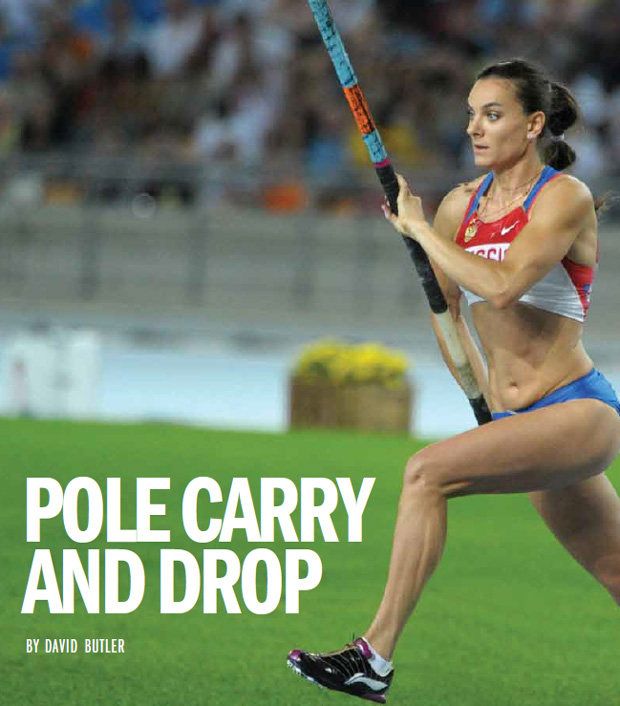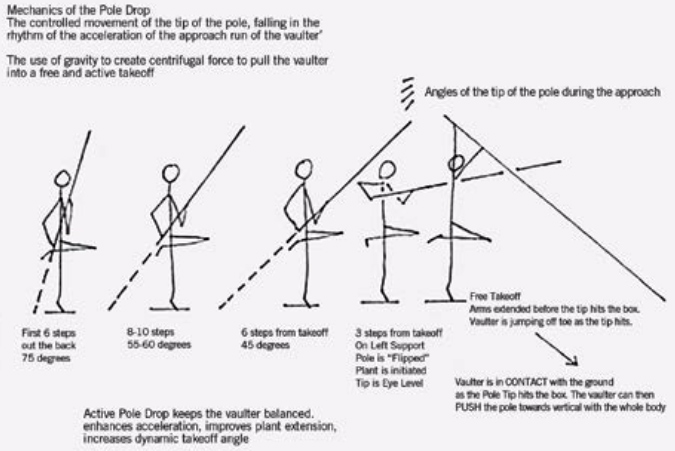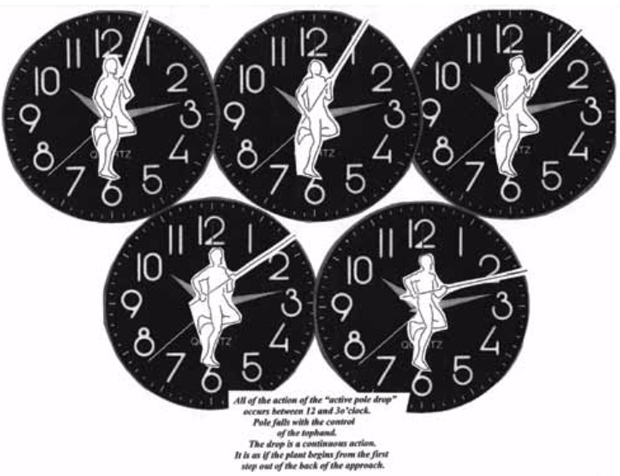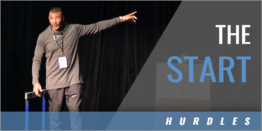| Pole Carry and Drop |
| By: David Butler
Originally Published in: Techniques Magazine - Provided by: USTFCCCA
 When Vitali told me of his "inspirations" that moved him to develop "active pole drop" and "free takeoff," I did some research of my own. I watched old films of the 1936, 1948, 1956, 1964, 1980 Olympics and, of course, Sergei Bubka. I watched Bob Richards win the gold medal with his takeoff dynamic, jumping off his big toe just as his steel pole hit the box. A free takeoff! I talked to Dr. Fred Hansen, 1964 gold medalist (and my dentist), and he told me that he would take off just a little "out" because he found that he could get the pole higher before it bent! A free takeoff! Bubka's pole tip never stops dropping, falling in the rhythm of his accelerating approach! Active pole drop! An "active pole drop"creates a faster approach and the movement of the pole to vertical before it bends, resulting in stiffer poles and higher grips for the vaulter! An "active pole drop" enhances the plant and improves the take-off angle of the vaulter, creating a "free takeoff position". Want to hold higher, get on longer poles, get on stiffer poles and PR! Improve your carry and pole drop! THE POLE IS A WEIGHT IN YOUR HANDS! The correct pole carry is extremely important to the movement of the pole to takeoff. The "old" elbow out, tight wrist (bottom hand), open hand (top hand) carry creates tension and the inability to control the pole's weight as it drops towards the box. Rather, the vaulter should have the bottom arm, elbow tucked, wrist cocked with the pole resting in a relaxed, open-handed grip. The top hand has a full grip on the pole! This allows the vaulter to be one with the pole! The pole is not lowered with the front arm; it is lowered with the top hand traveling up through the vaulter's side or back ribs. The pole rotates in the front arm (fulcrum). The pole's weight must be centered through the vaulter's body so that the athlete may sprint upright, fast and free! Hold the pole out in front and the vaulter will decelerate to counter the weight, either falling forward or leaning back. Try running with a barbell, dumbbells, or medball held out in front of you; it will be very difficult to jump with that weight static and throwing your body off balance.
OUT OF THE BACK The plant begins with the first step out of the back of your approach. Depending on the length of your run, the pole tip is held at such an angle so that the vaulter can time the drop of the pole in total synchronization with the acceleration of approach. The pole tip is at 70 degrees from a long approach, almost at vertical. The handspread should be at the width of the distance between your hands when the vaulter jumps up to hang from a horizontal bar. The first three to four steps are extremely important, establishing a gradual acceleration, powerful, hips tucked, knees up, toes up, tall and upright, pole in line with the displacement of the body, from tip to toe. The tip of the pole begins to fall the moment the vaulter moves. SYCHRONIZATION AND ACCELERATION As the vaulter runs faster, the pole drops faster, a continuous movement in coordination with the sprinting action to takeoff. The tip should not look like the "tick-tock" action of a clock. It should be "one fluid movement." The weight of the pole transfers gradually from the top hand to the bottom hand, the top hand controlling the fall. An active pole pulls the vaulter down the runway once he or she has pushed the pole out of the back. The top hand "releases the hip" as the pole drops off six steps out from the takeoff. Releasing the hip means not holding the pole to the hip but focusing on keeping the bottom arm within line of the body, the top hand slightly behind the vaulter. This centering of balance with the pole allows the drop to be free and the vaulter to stay upright and in the position to jump at takeoff. If the tip drops too early, the vaulter will chop his/her step or reach/overstride to counteract the weight of the static pole. If the vaulter holds the pole tip too high and attempts to drop it fast into the last few steps, he/she will have to decelerate to plant the pole. This active pole drop greatly enhances the vaulter's ability to "turn over their strides" and accelerate into a dynamic takeoff! Recommendation: Try approaches on the track with a low, static pole carry and an active, dynamic pole drop. With the active carry and drop, you will have to back your run up 2 to 6 feet because you will be running so much faster! THE PLANT The plant is a continuation of the running motion of your arms, left arm raising the pole up, fist through eye level and the top (right) hand passing in a straight line through the hip, ribs, shoulder, cheek, eyes, forehead; and fully extended above the vaulter. The movement begins three steps out from takeoff. As the vaulter sprints onto his/her left foot (right handed vaulter), the pole tip is eye-level or, in the least, above horizontal to the runway. The action of the "top up, tip down" creates a weightless pole! Driving from the left foot, the vaulter "flips" the pole, bringing it just in front of the right shoulder. As the vault steps onto his/her penultimate (right) foot, the pole passes through the right eye and pushes above the forehead. As the vaulter hits his/her takeoff foot, the arms thrust up, fully extended. Think "push pole" or "make space," getting the pole as high as possible before it bends! The action of the arms must be in complete rhythm and coordination of the movement of the legs. Recommendation: Perform a four-step slow motion walking plant. You will discover the vaulter's plant timing and rhythm. This will improve their awareness of where the pole needs to be in coordination with their steps. ELASTIC FREE TAKEOFF This is crucial! As the vaulter goes airborne, he/she must continue the plant , following through by allowing the left arm to give with the bend of the pole. The left must become elastic, stretching above the vaulter's head as he/she drives his head and chest through the arms. It's called "taking it to the top hand," as if the vaulter was sliding his/her bottom hand up to the top hand, like the vaulters did before fiberglass. The arms opening and expanding with the bend of the pole will make the vaulter's body even longer and that extension keeps the pole bending and "rolling over" towards the crossbar. A good term is "chasing the pole" or "jumping over the tip." Rather than thinking that the pole stops in the box, think of rotating the pole over the tip! Free takeoff is when the vaulter is jumping off of the right foot just as the tip hits the back of the box and "the pole is straight" and reaching its highest point towards vertical before it bends. Head position should be up and looking through the arms, not tucked into the chest. Bubka states, "In pole vaulting, the crucial factor is how to transfer energy to the pole, through the complete body of the vaulter. If the pole begins to bend while the vaulter is yet on the ground, it is impossible to transfer that energy ... it is lost in the box. When we perform a 'free takeoff,' we can feel the pushing action of the whole body." Recommendation: On every drill and plant that you do, with the pole, on a rope or horizontal bar, always drive head, chest and hips through the arms. Elastic!
APPLICATION & DIRECTION OF ARM PRESSURE The terms "rowing" or "down-pressure" should be revised and reconsidered. From the elastic position, the arms will apply "up-pressure", above the vaulter, with the hands pushing and moving to 12 o'clock (arms pointing to vertical)! Any action down or forward will result in the swing col-lapsing into an L-seat or tuck position and the pole reacting to the shortening motion by unbending and decelerating its rotation towards the crossbar. The vaulter should "cover the arc of the pole" by swinging long and moving his/her arms "in the rhythm of the swing." In fact, I don't even talk about "up-pressure" until I get the vaulter on and long and planting correctly. Most young vaulters react to the pole negatively by tensing up shoulders, curling wrists, or collapsing the arms. Creating a positive relationship with the pole and plant is important: being relaxed, long, extended, and elastic. Many vaulters "block out" with their bottom arms and the only way they can swing to invert is by "breaking" or "flexing in" the bottom arm. Others are taught to "flex in" the bottom arm during drills, to get them to an inverted position. Doing this "swing- up" drill results in the vaulter not being able to get the bottom arm extended; therefore, the vaulter can get inverted but at the sacrifice of pole rotation. Recommendation: Study film of vaulters of all levels. Watch for the pole losing its speed of rotation; this slowing of the movement of the pole towards the crossbar is caused by pulling against the bend of the pole. Keep the arms up, and the vaulter will swing to the top. ONE FLUID CONTINUOUS MOVEMENT The Petrov Method or the Bubka Model can be summed up in a few words. The pole vault starts from the first step out of the back. The pole drop or movement starts and continues to move the moment the vaulter begins his/her approach. The pole tip should never "freeze" or become static. It must drop with the rhythm of the run. This model or method was developed from the great steel and bamboo technicians of the past. It is the essence of pole vaulting; whether vaulting with a straight pole or a bending pole, it's all about moving the pole to vertical! Active pole drop and free takeoff are the keys to holding higher, running faster and getting on stiffer poles! As Sergei Bubka says, "Move the pole towards the plane of the crossbar, rather than just trying to bend the pole." Recommendation: Vaulters should spend a lot of time performing a six-step straight pole vault , pushing the pole to vertical and rotating it to the pit. Do this drill without pulling down or beside the pole. Stay behind and "chase the pole" to vertical, always swinging under the arms. Drive your chest, torso and hips into the pole without pulling. Gradually move your grip up one fist at a time and your step back one of your feet for each fist. The better you plant and take off, the higher you can hold! Bubka says, "Bending poles hide technical mistakes, but stiff poles (straight pole vaulting) immediately hurt you! It forces you to learn the right action." "Some see, many understand, but very few grind away at correctness" - Golubtsov David Butler has been the pole vault coach at Rice University for over a decade. He has coached multiple All American vaulters including 2009 Division 1 Indoor & Outdoor champion Jason Colwick. |









